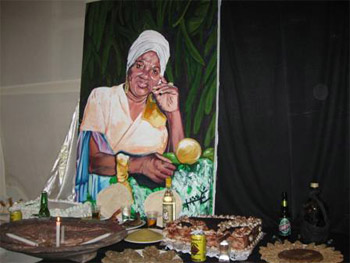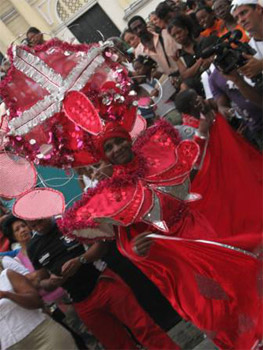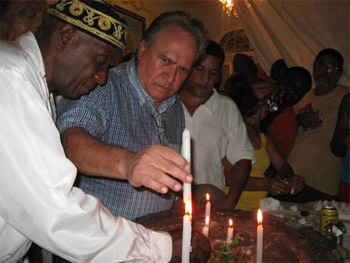Cuba: Victories, Cholera and Our Neighbors
By Haroldo Dilla Alfonso* (photos Janis Hernandez)

HAVANA TIMES — Cuba’s leaders like decisive and overwhelming victories, which is what they have proclaimed to the world for five decades. While it’s true that they’ve never been able to overcome economic inefficiencies, they did achieve crushing military victories several times, from the Bay of Pigs to Cuito Cuanavale (in Angola).
Accustomed as they are to taking part in such triumphs, in late August the Ministry of Public Health proclaimed that they had won their war against cholera after suffering a final toll of 417 people infected and three dead.
This was a big mistake, because vibrio cholerae isn’t so easily overcome – even less so when relying on quickly organized campaigns. Cholera is a disease that has a low mortality rate because the cure is relatively simple, nevertheless it’s exceedingly difficult to eradicate.
To do so requires a lot of time and care, much more than what the Cuban health authorities could provide. Therefore cholera has returned to the island, or — better said — it has reappeared, having never really left.
A first conclusion about how the cholera epidemic broke out in Cuba would be the deplorable sanitary conditions in the region, not because the infection has occurred, which can sometimes happen for a host of reasons, and regardless of one’s class or status.
In the Dominican Republic, for example, a wedding party of Venezuelan millionaires was infected during the festivities in a country estate, where they dined on infected ceviche. Though no one died, the toilets of Caracas were under a tremendous siege for several days.

Nor can a conclusion be made because three patients died in Cuba, which is a very low number and indicates the promptness of the island’s health care services.
But the fact that four hundred people became infected in such a short time does demonstrate the magnitude that should induce the government to focus its allocations on the provision of an improved water supply and better sanitation conditions in these regions, which remain among the poorest in the country.
The other issue is the origin of the ailment. There had been no cholera in the Caribbean for over a century.
It reappeared in Haiti a couple of years ago not because the poverty of the Haitians created it, but because UN troops — particularly a Nepalese contingent — sowed it in the Artibonite River from their poorly constructed latrines. Since then it has killed more than 7,000 people and sickened nearly 600,000.
From there it’s likely that it was carried in the intestines of a Cuban internationalist aid worker or in a fish that made its way to the town of Manzanillo. So far this hasn’t been explained, so I suspect that it was an internationalist aid worker.
I haven’t been following or keeping up with the epidemic, I’m not a doctor. But I think this issue forces us to think more seriously about Cuba’s relations with Haiti, a topic I’ve addressed several times before.
The history of eastern Cuban has always been linked to Haiti. In 1900 there began arriving in our country hundreds of thousands of Haitian workers, who’s labor made possible the great harvests of the 1920s. Many of them were temporary and were repatriated when the harvest ended, but others remained in the country.
In 1931, the census counted almost 80,000 of them. In 1953 — when the flow was for the most part had stopped, many had assumed Cuban citizenship — they numbered 28,000. The descendants of these people, who maintain a long-term cultural ingredient, are currently estimated at about 80,000.
Haitian cultural vitality — one of the greatest riches of this country — can be seen in the eastern region, where people of that origin still populate many of the old still existing sugarcane towns and constitute the leading parts of the unforgettable programs of the Caribbean festivals in Santiago de Cuba.
I’m sure that the current demographic situation in Cuba could induce the reactivation of migratory flows. At the same time that Haiti continues to lose population from emigration, all of eastern Cuba (especially its southern side) is experiencing depopulation due to low growth rates and migration from eastern Cuba to Havana (while Havanans are migrating to south Florida).

Across the island the population is aging and stagnant or in a process of absolute reduction.
The island of Cuba needs a workforce, especially if it continues the current process of economic liberalization and privatization of agricultural land. Many Haitians could find a stimulus to emigrate to Cuba, where currently many thousands of Haitians already live, particularly in the southeastern region; there, their customs and religious beliefs wouldn’t be strange in the least.
This wouldn’t make us unique, because Haitians have spread throughout the Caribbean, forming strong communities in the Dominican Republic, the Bahamas, the Turks and Caicos, Guadeloupe, Cayenne, and of course in Miami – where they live in segregated neighborhoods (residential segregation is a fact of that city, particularly in Little Haiti). In all these places they are key pieces of the local economies.
This is why what cholera indicates is more than an epidemic. It’s a relationship that will grow and will require special handling. It will not be solved in a quick and crushing victory, like the one that supposedly befell vibrio cholerae earlier this year but that still haunts us from the quagmire of Manzanillo.
—–
(*) Originally published by Cubaencuentro.com

Cuando VA Usted a escribir algo elogiando a such Patria? Es tan feo hablar mal details la Patria estando fuera de ella! Vaya alla y digaselo a Los cubanos details la island…
Cuba does need work on its plumbing for sure — you cannot drink public water in Havana itself. But I’d still rather live on that island than on its US-dominated neighbors.
Cubans have no work yet here you are inviting the Haitians to move in and work the jobs that don’t exist. What is wrong with that picture?